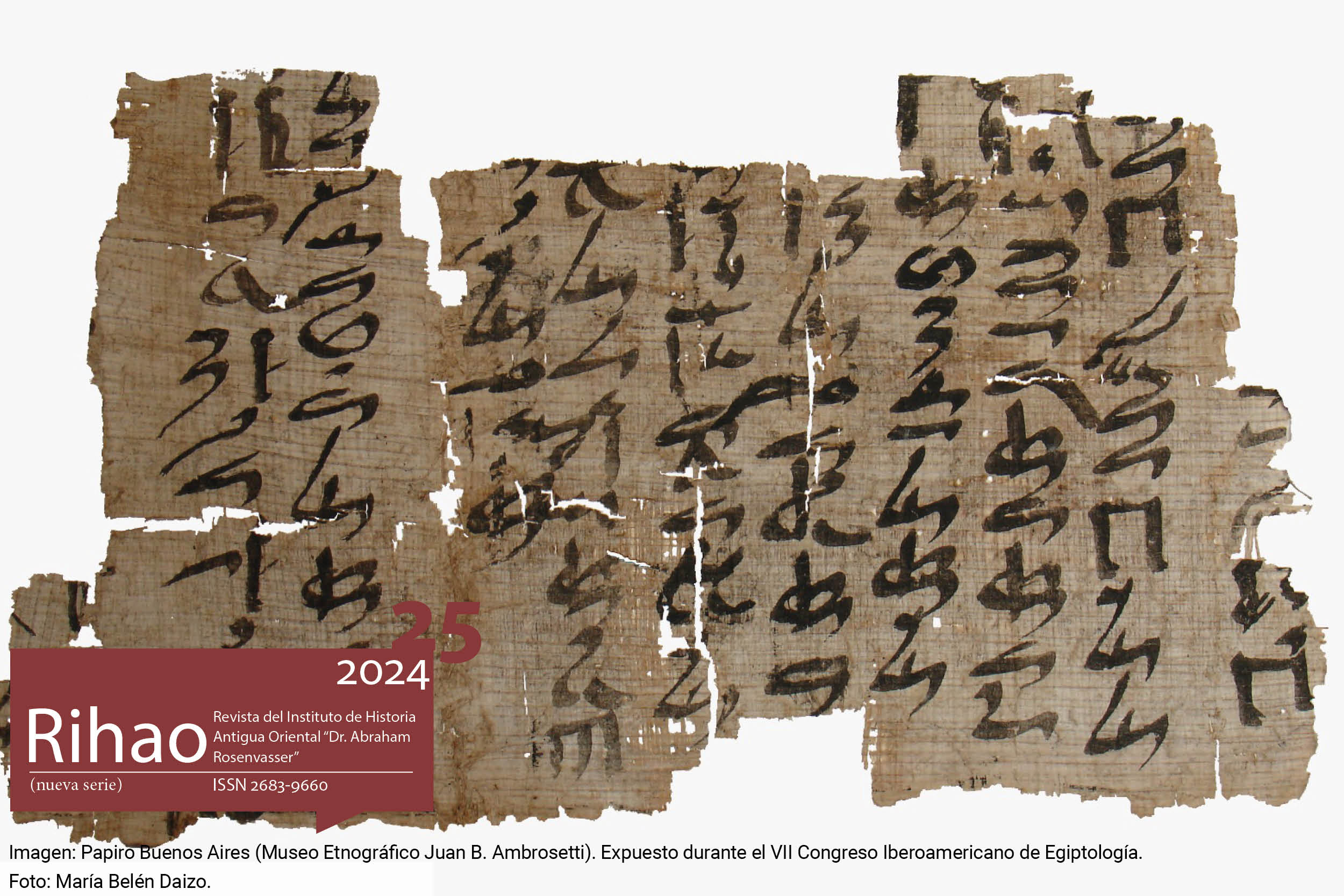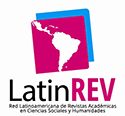Pastoralismo y circulación de bienes en la península del Sinaí durante el Predinástico y el Dinástico Temprano
Resumo
En este trabajo analizaremos el rol de los pastores móviles en la extracción y circulación de bienes en la península del Sinaí, durante los períodos Predinástico y Dinástico Temprano, en el marco general de las relaciones entre el valle del Nilo y el Levante meridional. Consideramos que las prácticas pastoriles y de caravaneo de las poblaciones del Sinaí pudieron ser de relevancia para el establecimiento de las primeras rutas de circulación en la región y el desarrollo de las inte-racciones interregionales. Posteriormente, los egipcios podrían haberse valido de esas mismas rutas, y quizás de sus agentes, para controlar el aprovisionamiento de ciertos bienes suntuarios, en el marco del proceso de cambio asociado al surgimiento del Estado. Para abordar este tópico, y a partir de un enfoque internodal, se identificarán las evidencias arqueológicas de tráfico de bienes en el Sinaí y se intentará establecer los posibles corredores por los que circularían tales bienes. Se propondrán también algunas consideraciones sobre las implicancias del caravaneo en el desarrollo de las interacciones interregionales.Downloads
Referências
Abdel-Motelib, A., Bode, M., Hartmann, R., Hartung, U., Hauptmann, A. y Pfeiffer, K. (2012). Archaeometallurgical expeditions to the Sinai Peninsula and the Eastern Desert of Egypt (2006, 2008), en: Metalla 19 (1/2): 3-59.
Adams, R. B. (2003). External Inluences at Faynan During the Early Bronze Age: A Re-analysis of Building 1 at Barqa El-Hetiye, Jordan, en: Palestine Exploration Quarterly 135 (1): 6-21.
Anfinset, N. (2010). Metal, Nomads and Culture Contact. The Middle East and North Africa. Londres / Oakville: Equinox Publishing.
Aubet, M. E. (2007). Comercio y colonialismo en el Próximo Oriente Antiguo. Los antecedentes coloniales del III y II milenios a. C. Barcelona: Bellaterra.
Avner, U. (2002). Studies in the Material and Spiritual Culture of the Negev and Sinai Populations, During the 6th-3rd Millennia B.C. Tesis doctoral. Jerusalén: Hebrew University.
Avner, U. (2018). Protohistoric Developments of Religion and Cult in the Negev Desert, en: Tel Aviv 45 (1): 23-62.
Bar-Yosef, O., Belfer-Cohen, A., Goren, A. y Smith, P. (1977). The Nawamis near ’Ein Huderah (Eastern Sinai), en: Israel Exploration Journal 27 (2): 65-88.
Bar-Yosef, O., Belfer-Cohen, A., Goren, A., Hershkovitz, I., Ornit, I., Mienis, H. K. y Sass, B. (1986). Nawamis and Habitation Sites near Gebel Gunna, Southern Sinai, en: Israel Exploration Journal 36 (3): 121-167.
Beit-Arieh, I. (2003). Archaeology of Sinai: The Ophir Expedition. Tel Aviv: Tel Aviv University Yass Publications in Archaeology.
Ben-Yosef, E. (2018). Provenancing Egyptian metals: A methodological comment, en: Journal of Archaeological Science 96: 208-215.
Berenguer, J. (1994). Asentamientos, caravaneros y tráfico de larga distancia en el norte de Chile: el caso de Santa Bárbara, en: Albeck, M. E. (ed.), De costa a selva: intercambio y producción en los Andes Centro-Sur. Buenos Aires: Instituto Interdisciplinario Tilcara, Universidad de Buenos Aires, 17-50.
Braun, E. (2002). Egypt’s First Sojourn in Canaan, en: van den Brink, E. C. M. y Levy, T. E. (eds.), Egypt and the Levant. Interrelations from the 4th through the Early 3rd Millennium B.C.E. Londres / Nueva York: Leicester University Press, 173-189.
Campagno, M. (2010). Centros y periferias en las relaciones entre el valle del Nilo y el Levante meridional en torno del Bronce Antiguo (ca. 3700-2700 a.C.), en: Di Bennardis, C., D’Agostino, F., Silva Castillo, J. y Milevski, I. (eds.), Relaciones centro urbano-periferia en la Mesopotamia antigua y zonas contiguas del Cercano Oriente, Rivista Degli Studi Orientali 83: 189-214.
Campagno, M. (2018). Lógicas sociales en el Antiguo Egipto. Diez estudios. Buenos Aires: Editorial de la Facultad de Filosofía y Letras, Universidad de Buenos Aires.
Campagno, M., Gandulla, B. y Milevski, I. (eds.) (2022). Relaciones entre Egipto y Palestina en el IV milenio a.C. Modelos e interpretaciones. Buenos Aires: Miño y Dávila.
Chang, C. y Koster, H. A. (1986). Beyond Bones: Toward an Archaeology of Pastoralism, en: Advances in Archaeological Method and Theory 9 (1986): 97-148.
de Miroschedji, P., Sadeq, M., Faltings, D., Boulez, V., Naggiar-Moliner, L., Sykes, N. y Tengberg, M. (2001). Les fouilles de Tell es-Sakan (Gaza): nouvelles données sur les contacts égypto-cananéens aux IVe-IIIe millénaires, en: Paléorient 27 (2): 75-104.
Finkelstein, I. (1995). Living on the Fringe. The Archaeology and History of the Negev, Sinai and Neighbouring Regions in the Bronze and Iron Ages. Sheffield: Sheffield Academic Press.
Gophna, R. (1990). The Early Bronze I Settlement at ‘En Besor Oasis, en: Israel Exploration Journal 40: 1-11.
Greenberg, R. (2019). The Archaeology of the Bronze Age Levant. From Urban Origins to the Demise of City-States, 3700-1000 BCE. Cambridge: Cambridge University Press.
Hauptmann, A. (2007). The Archaeometallurgy of Copper. Evidence from Faynan, Jordan. Berlín: Springer.
Hoffmeier, J. H. y Moshier, S. O. (2013). “A Highway out of Egypt”: The Main Road from Egypt to Canaan, en: Förster, F. y Riemer, H. (eds.), Desert Road Archaeology in Ancient Egypt and Beyond. Colonia: Heinrich-Barth-Institut, 485-511.
Honeychurch, W. y Makarewicz, C. A. (2016). The Archaeology of Pastoral Nomadism, en: Annual Review of Anthropology 45 (1): 341-359.
Horwitz, L. K. (2019). Animal Offerings from the Nawamis Fields and Coeval Habitation Sites in Southern Sinai, en: Goldfus, H., Mayer, I., Gruber, I., Yonah, S. y Fabian, P. (eds.), Studies in Archaeology and Ancient Cultures in Honor of Isaac Gilead. Oxford: Archaeopress Archaeology, 131-145.
Horwitz, L. K. (2022). Dynamics of Early Bronze Age Faunal Exploitation in the Sinai Peninsula: Modes of Production, Commodity Production and Trade, en: Adams, M. J. y Roux, V. (eds.), Transitions during the Early Bronze Age in the Levant. Methodological Problems and Interpretative Perspectives. Münster: Zaphon, 265-284.
Khazanov, A. M. (1984). Nomads and the Outside World. Madison: The University of Wisconsin Press.
Levy, T. E. (2007). Journey to the Copper Age: Archaeology in the Holy Land. San Diego: San Diego Museum of Man.
Levy, T. E. y van den Brink, E. C. M. (2002). Interaction Models, Egypt and the Levantine Periphery, en: van den Brink, E. C. M. y Levy, T. E. (eds.), Egypt and the Levant. Interrelations from the 4th through the Early 3rd Millennium B.C.E. Londres / Nueva York: Leicester University Press, 3-39.
Milevski, I. (2016). Intercambio de productos en el Levante meridional durante el Bronce Antiguo. Una perspectiva marxista. Barcelona: Bellaterra.
Milevski, I., Campagno, M., Gandulla, B., Jaruf, P., Daizo, M. B., Czarnowicz, M., Ochał-Czarnowicz, A., Karmowski, J., Yegorov, D., Cohen-Sasson, E. y Yekutieli, Y. (2019). Tel Erani, Israel: Reporte de la campaña arqueológica de 2018 y sus antecedentes, en: Revista del Instituto de Historia Antigua Oriental “Dr. Abraham Rosenvasser” 20: 5-22. En línea: https://doi.org/10.34096/rihao.n20.7108. [Consultado: 28-10-2023].
Nielsen, A. E. (2006). Estudios internodales e interacción interregional en los Andes circumpuneños: teoría, método y ejemplos de aplicación, en: Lechtman, H. (ed.), Esferas de interacción prehistóricas y fronteras nacionales modernas: los Andes Sur centrales. Lima: Instituto de Estudios Peruanos - Institute of Andean Research, 29-62.
Nielsen, A. E. (2017). Actualidad y potencial de la arqueología internodal surandina, en: Estudios Atacameños 56: 299-317.
Oren, E. D. (1986). Early Bronze Age Settlement in Northern Sinai: A Model for Egypto-Canaanite Interconnections, en: de Miroschedji, P. (ed.), L’urbanisation de la Palestine à l’âge du Bronze ancien. Oxford: BAR International Series, 389-405.
Oren, E. D. y Gilead, I. (1981). Chalcolithic Sites in Northeastern Sinai, en: Tel Aviv 8 (1): 25-44.
Rademakers, F. W., Verly, G., Delvaux, L. y Degryse, P. (2018). Copper for the afterlife in Predynastic to Old Kingdom Egypt: Provenance characterization by chemical and lead isotope analysis (RMAH collection, Belgium), en: Journal of Archaeological Science 96: 175-190.
Renfrew, C. M. (1975). Trade as action at a distance: Questions of integration and communication, en: Sabloff, J. A. y Lamberg-Karlovsky, C. C. (eds.), Ancient Civilization and Trade. Albuquerque: University of New Mexico Press, 3-59.
Rosen, S. A. (2017). Revolutions in the Desert. The Rise of Mobile Pastoralism in the Negev and the Arid Zones of the Southern Levant. Londres / Nueva York: Routledge.
Tallet, P. (2010). Le roi Den et les Iountiou. Les Égyptiens au Sud-Sinaï sous la 1re dynastie, en: Archéo-Nil 20: 97-105.
van den Brink, E. C. M. y Levy, T. E. (eds.) (2002). Egypt and the Levant, Interrelations from the 4th through the Early 3rd Millennium B.C.E. Londres / Nueva York: Leicester University Press.
Yekutieli, Y. (2002). Settlement and Subsistence Patterns in North Sinai during the Fifth to Third Millennia BCE, en: van den Brink, E. C. M. y Levy, T. E. (eds.), Egypt and the Levant, Interrelations from the 4th through the Early 3rd Millennium B.C.E. Londres / Nueva York: Leicester University Press, 422-433.
Copyright (c) 2024 Ezequiel Cismondi

This work is licensed under a Creative Commons Attribution-NonCommercial 4.0 International License.





.jpg)







